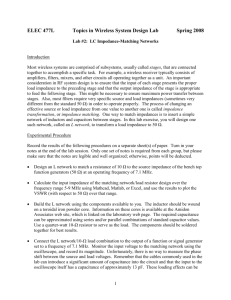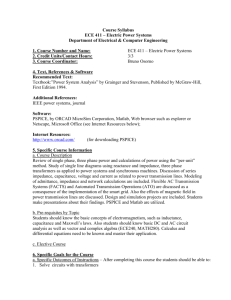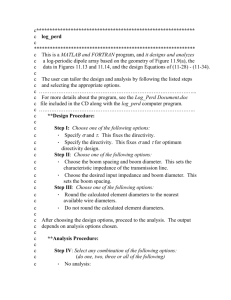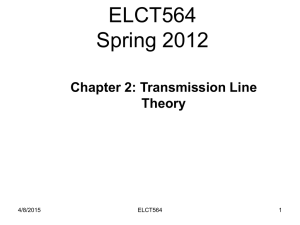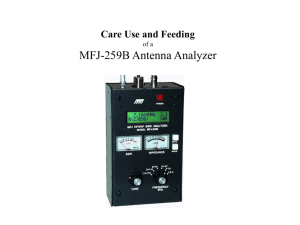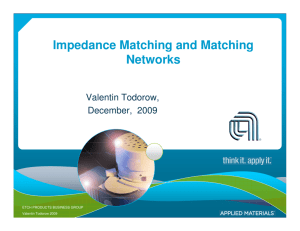Radio Frequency (RF) Hardware for Laboratory Experiments
advertisement
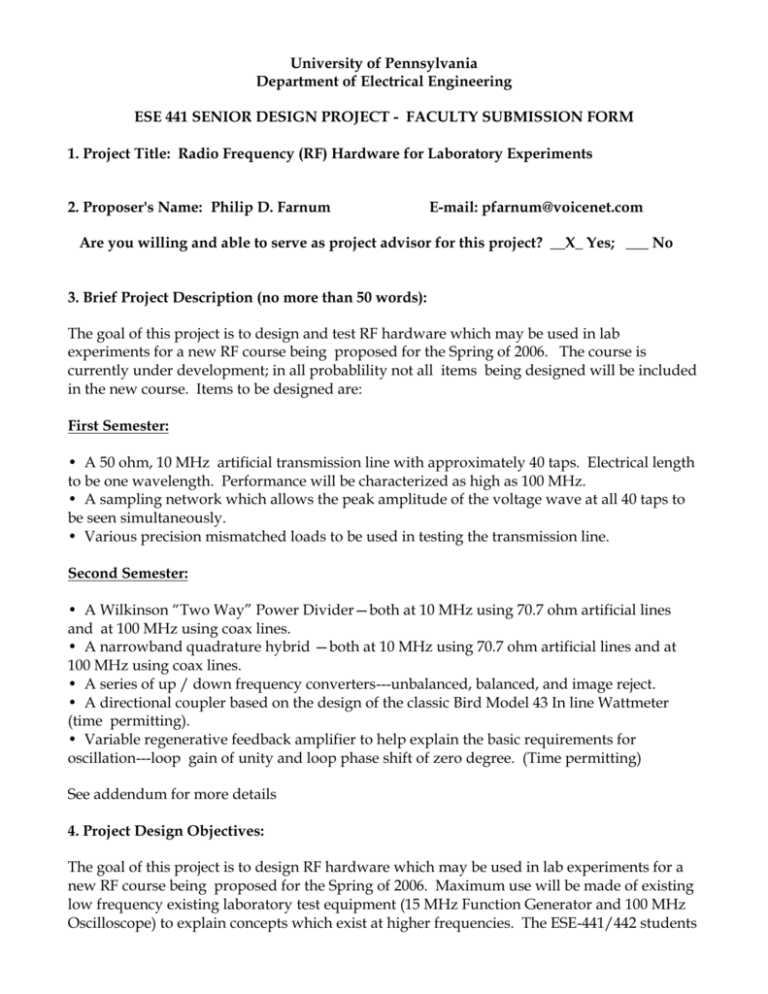
University of Pennsylvania Department of Electrical Engineering ESE 441 SENIOR DESIGN PROJECT - FACULTY SUBMISSION FORM 1. Project Title: Radio Frequency (RF) Hardware for Laboratory Experiments 2. Proposer's Name: Philip D. Farnum E-mail: pfarnum@voicenet.com Are you willing and able to serve as project advisor for this project? __X_ Yes; ___ No 3. Brief Project Description (no more than 50 words): The goal of this project is to design and test RF hardware which may be used in lab experiments for a new RF course being proposed for the Spring of 2006. The course is currently under development; in all probablility not all items being designed will be included in the new course. Items to be designed are: First Semester: • A 50 ohm, 10 MHz artificial transmission line with approximately 40 taps. Electrical length to be one wavelength. Performance will be characterized as high as 100 MHz. • A sampling network which allows the peak amplitude of the voltage wave at all 40 taps to be seen simultaneously. • Various precision mismatched loads to be used in testing the transmission line. Second Semester: • A Wilkinson “Two Way” Power Divider—both at 10 MHz using 70.7 ohm artificial lines and at 100 MHz using coax lines. • A narrowband quadrature hybrid —both at 10 MHz using 70.7 ohm artificial lines and at 100 MHz using coax lines. • A series of up / down frequency converters---unbalanced, balanced, and image reject. • A directional coupler based on the design of the classic Bird Model 43 In line Wattmeter (time permitting). • Variable regenerative feedback amplifier to help explain the basic requirements for oscillation---loop gain of unity and loop phase shift of zero degree. (Time permitting) See addendum for more details 4. Project Design Objectives: The goal of this project is to design RF hardware which may be used in lab experiments for a new RF course being proposed for the Spring of 2006. Maximum use will be made of existing low frequency existing laboratory test equipment (15 MHz Function Generator and 100 MHz Oscilloscope) to explain concepts which exist at higher frequencies. The ESE-441/442 students will not only design and analyze the hardware, they will prepare drafts of the lab experiments which may be used in the new course. 5. Project Prerequisites: What specific knowledge (e.g. courses or topics) and skills (e.g. programming languages or software packages) will this project require? Please rank order the knowledge and skills you have identified, with the most important at the top of the list. Analog circuit design and analysis Digital design (for sampling network) Addendum 1. Artificial Transmission Lines—An artificial transmission line is a network of discrete inductive and capacitive elements which has properties similar to those of a real transmission line with distributed elements. Using discrete elements, it can be made at low frequencies and enables students to study the properties of transmission lines using readily available test equipment. An envelope detector will be placed at each node of the line. A sampling network, synchronized with the horizontal sweep of an oscilloscope, will be designed so that the voltage standing wave created by a mismatched load impedance may be observed. 2. Wilkinson Power Divider ---A Wilkinson Power Divider is used in transmitters where one transistor is not capable of delivering all of the RF power that is required. In this situation a power divider splits the power from the driving transistor and delivers half to each of two output transistors. The division is “independent” of the input impedance of the two output transistors. For example….assume that the input impedance of the two output transistors was not equal…that one was 50 ohms and the other 100 ohms. Simply paralleling the two loads would cause an unequal distribution of the drive power. The device with the 50 ohm input impedance would take twice as much power as the device with the 100 ohm input impedance and would probably overheat. Using a power divider (and there are other types than a Wilkinson), the power division is much more equal. Wilkinsons are also used in image reject up / downconverters. In our design, artificial and distributed Wilkinsons dividers will be fabricated and tested to show that the power to one load remains “constant” when the other load is varied from a short circuit to an open circuit. 3. Quadrature Hybrids---A narrow band quadrature hybrid can be fabricated by adding a quarter wavelength line to one of the one of the outputs of a Wilkinson power divider (broadband “quads” used a different construction technique). This network has the very desirable property of maintaining a 50 ohm input impedance when driving two identical mismatched loads---even if those loads are short circuits! Quads are often used between the driving transistor and two output transistors in power amplifiers. Designing a driver stage is difficult enough when one has a known, fixed load impedance…having a variable load impedance makes the task even more difficult. Using a “quad” as part of the interstage circuitry stabilizes the driver load impedance and “makes life more easy” for the designer! Quads are also used in image reject downconverters. 4. Up / Down Converters At the heart of every radio receiver (AM, FM, TV, VCR, Radar) is a frequency converter. An experiment will be designed to show how these devices work.—their benefits and their drawbacks. The properties of a simple diode mixer will be examined. A double balanced mixer (four diodes and a transformer in a ring configuration) will then be fabricated and tested as well as an image reject mixer used in integrated circuit up / downconverters. 5. Directional Couplers (time permitting) Precision directional couplers are used in all high frequency impedance analyzers. When inserted in series with a line feeding an unknown impedance, a directional coupler can separate waves traveling toward the load from those being reflected from the load and traveling in the opposite direction. Knowing the magnitude and phase relationship of the forward and reflected waves allows one to calculate the value of the load impedance. Bird Electronics has manufactured the Model 43 Portable In-line Wattmeter for over 50 years. It will be the basis for our fixed element directional coupler design . 6. Oscillator Design (time permitting )---It has often been said that the two criteria required to turn an amplifier into an oscillator are : ”loop gain of unity and loop phase shift of zero degrees”. Where did those criteria come from? The goal of this deign is to construct a lab experiment in which there is independent control of the amplitude and phase of the feedback signal around an audio amplifier, allowing degenerative and regenerative effects to be observed. Oscillators are important circuit components as they are the devices which drive up / down converters into their non-linear regions.
